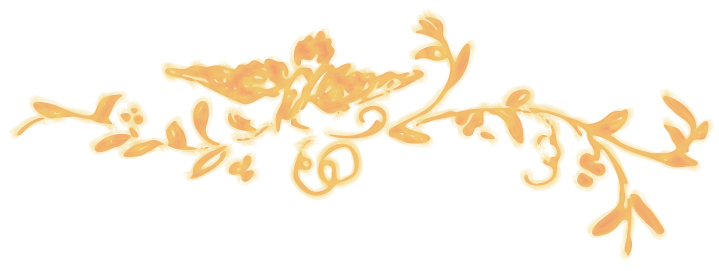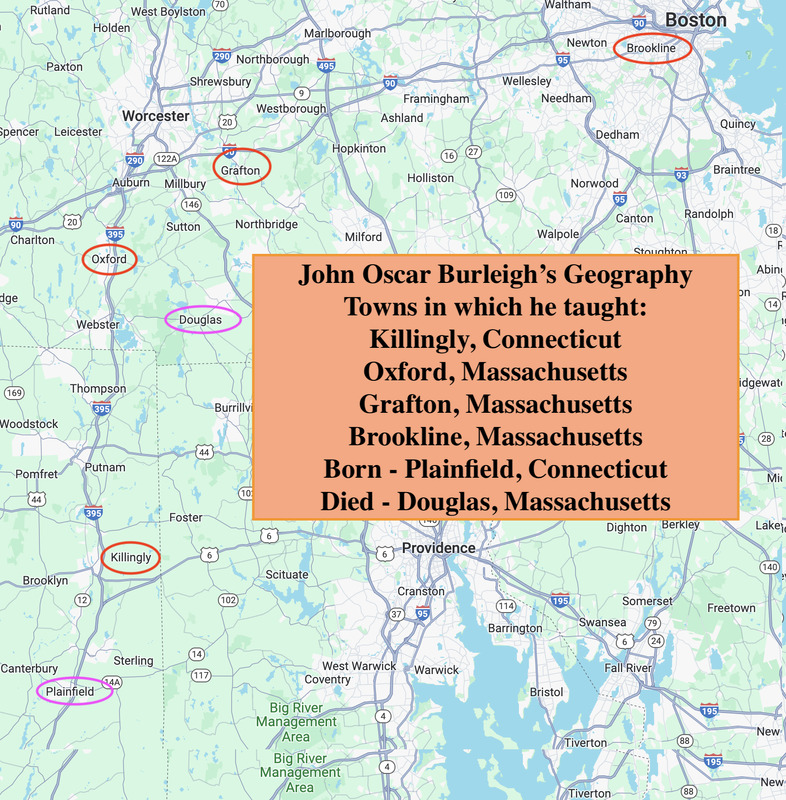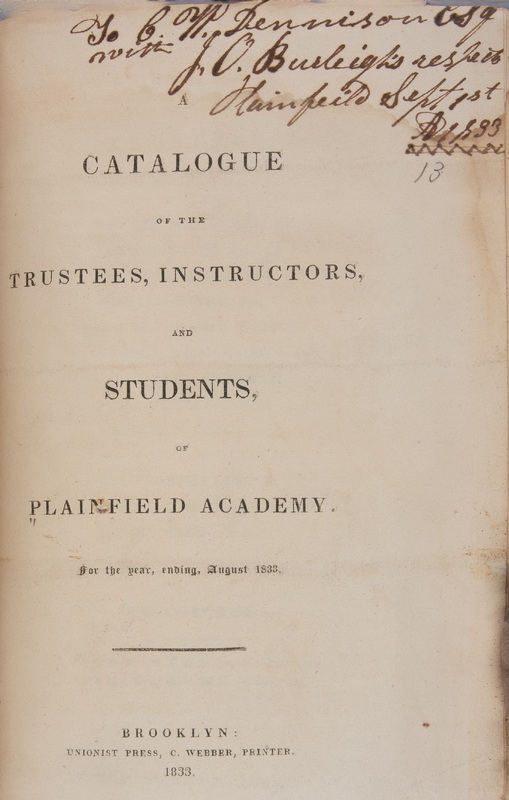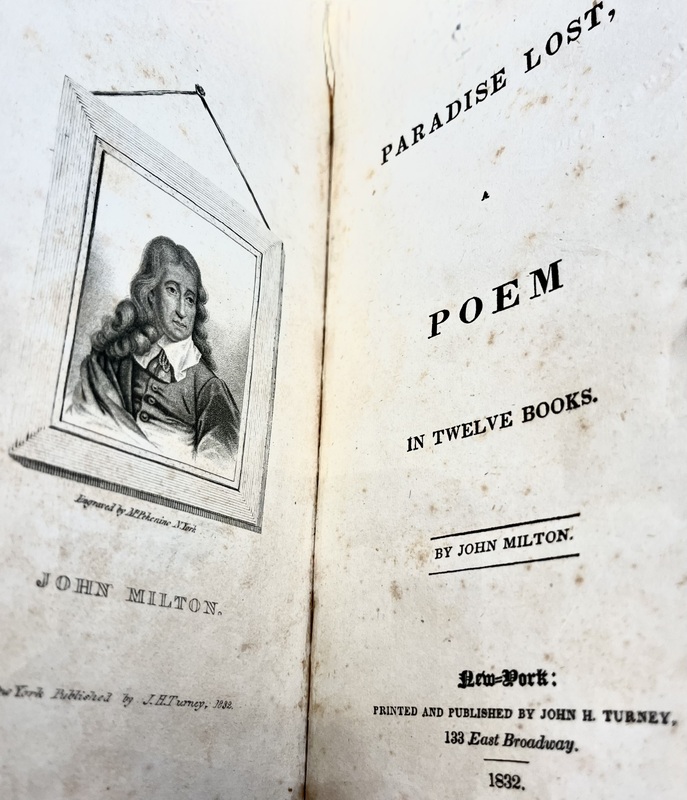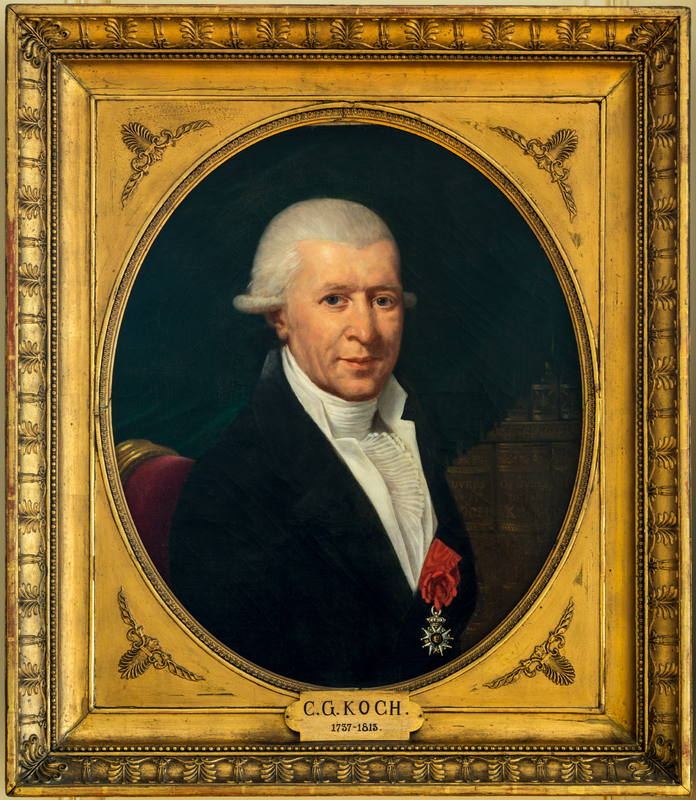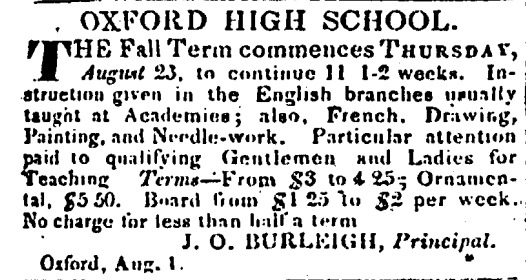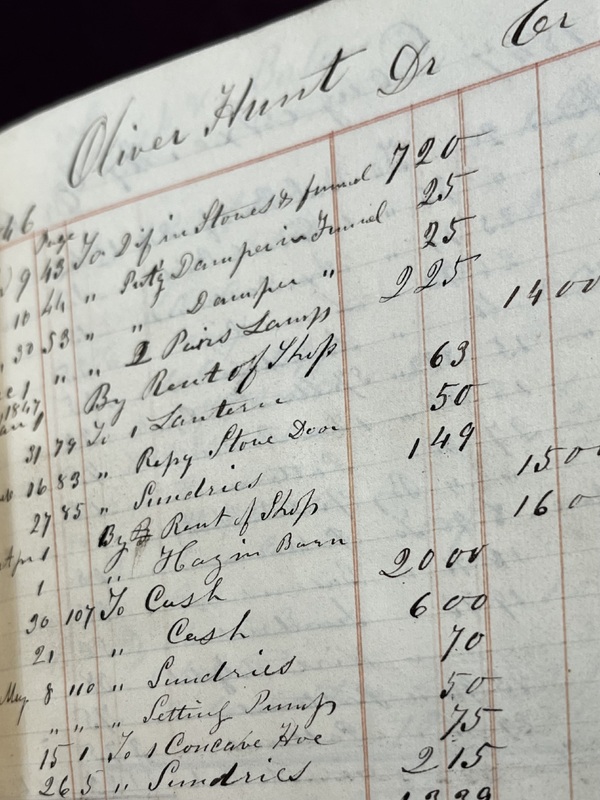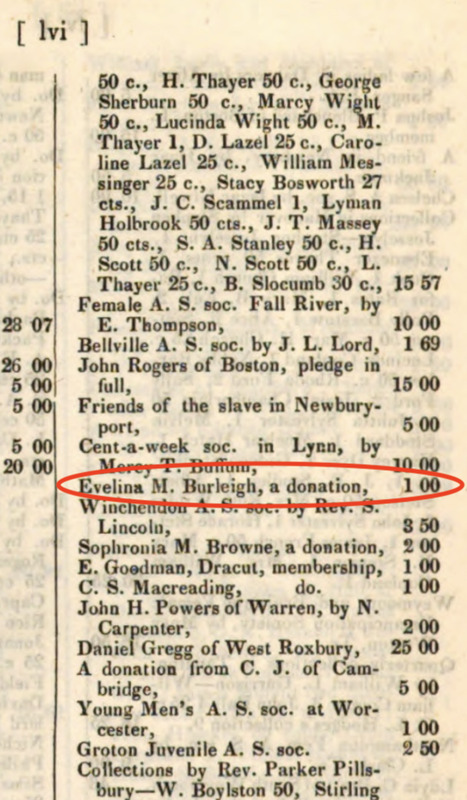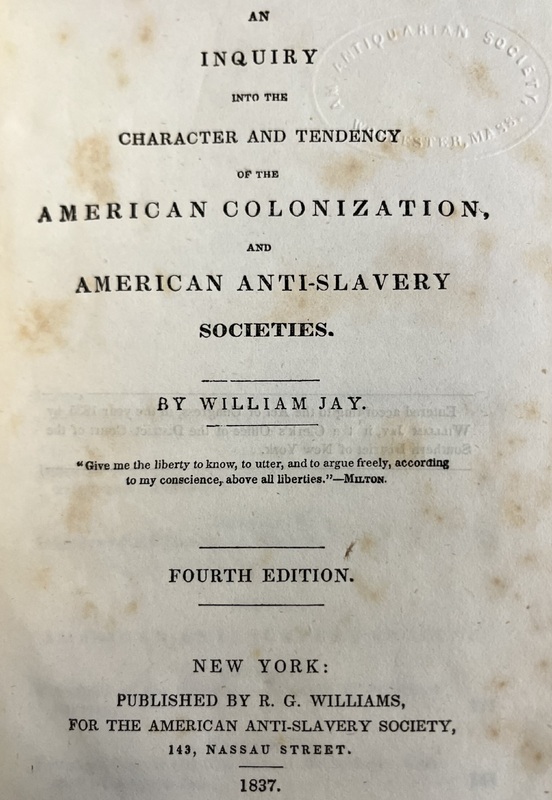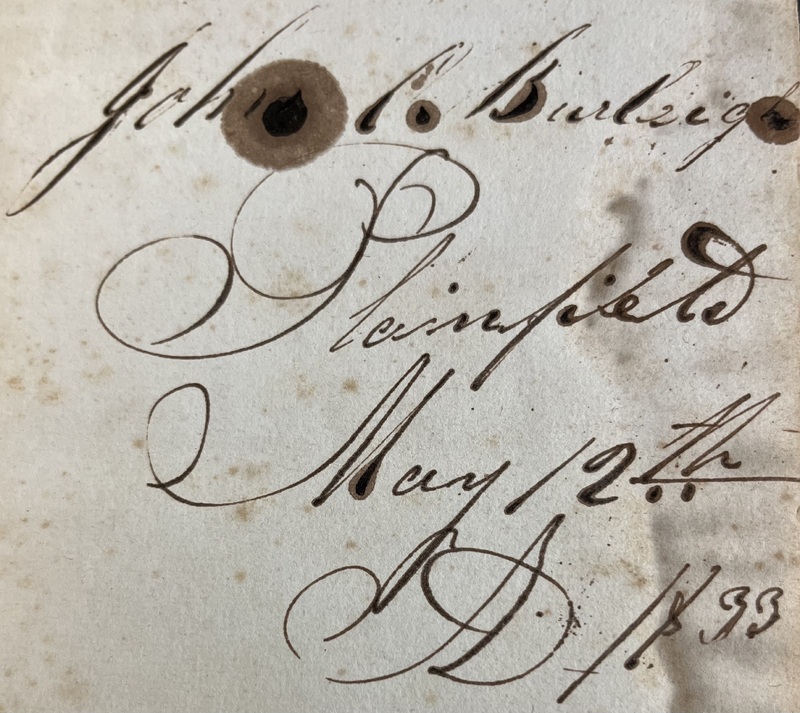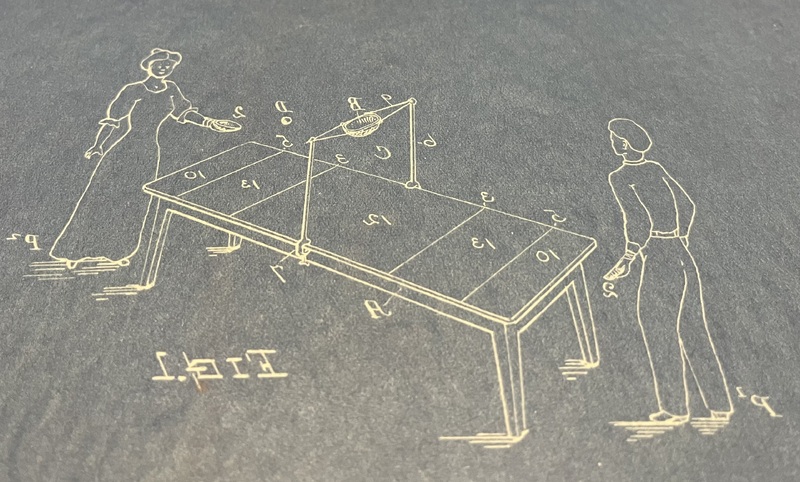John Oscar Burleigh: The Oldest, But Least Famed Brother
John Oscar Burleigh Basics
b. June 8, 1809, Plainfield, Connecticut
d. July 21, 1848, Douglas, Massachusetts
m. Evelina Moore (1817-1882), July 17, 1837, Oxford, Massachusetts
lived in Connecticut through ca. 1834; Massachusetts ca. 1834-1848
I. John Oscar Burleigh: Everyday Abolitionist
For the eldest son in such a distinguished family to be the least famed of the group is unusual. However, he is still important because he remained committed to the causes of reform, Abolition in particular, although his everyday life and work occupied most of his time. While concentrated research into the annals of Worcester-area Abolitionism remains to be done, to the best of our current knowledge, John did not become an officer, leader, or key author in the Abolition movement once he left Plainfield. He attended meetings in his adopted home, donated to the cause, and spent time with his brothers when they visited the Worcester area in their travels. Donation records (noted below) indicate that John and his wife Evelina attended some anti-slavery meetings in the area, and William Henry Burleigh's obituary for John (transcribed below) describes his brother as an "efficient advocate and friend" to the "oppressed and needy."
The anti-slavery ranks were filled with everyday white people like John O. Burleigh - men and women who heard the call for honoring the equality of all humanity, and who responded, helping to build the larger chorus of anti-slavery sentiment that would eventually topple that massive crime against humanity. John is distinctive merely through his family name. This fortuitous mixing of the typical white participant with the high profile name provides a specific window into everyday communication networks around anti-slavery.
II. Education and the Canterbury Controversies
John Oscar Burleigh was born in 1809. He attended the district schools and then the Plainfield Academy. The books of his which were retained by his descendants and then donated to the American Antiquarian Society are mainly from the concluding years of his education (1830-1833). One such treasured volume is an 1832 edition of the great English Protestant epic poem, John Milton's Paradise Lost. John O. Burleigh obtained this book in 1833, as he was completing the transition between being a student himself and becomng a teacher. Another fascinating title in his collection was the oft-published History of the Revolutions in Europe, by the pedagogue and diplomat Christophe Wilhelm Koch, one of Goethe's teachers. This comprehensive volume covers over 1,000 years of European history: it was intended for a well-educated audience.
The Canterbury Female Academy, run by Prudence Crandall, brought out the activist in John between 1833 and 1834. On September 1, 1833, he gifted a signed copy of the Plainfield Academy Catalogue to Charles Wheeler Denison, the editor of The Emancipator, and an erstwhile mentor of his brother William. This dated signature implies that John appreciated Denison's support for the Canterbury school, which was being avidly covered in The Emancipator, and may even suggest that Denison had visited Canterbury recently.
John Oscar Burleigh joined the Anti-Slavery Society of Plainfield and Vicinity, later serving as the Secretary pro tem during periods in 1834. This organization had arisen largely because of the visibility of the Canterbury controversy. The work of the entire Burleigh family can be recognized in this letter from Samuel Joseph May to William Lloyd Garrison, that was published in The Liberator in January of 1834.
You will be happy to hear that public opinion is changing rapidly in this vicinity—and the people are coming to appreciate justly the importance of the Anti-Slavery cause, and the correctness of the principles of the abolitionists. Within a few months, I delivered addresses in four towns in this county....Several young men of excellent character have engaged in the work, and have also delivered addresses in several places—Mr. C. C. Burleigh, Mr. John Burleigh, and Mr. Albert Hinckley.
The change in public opinion noted by Rev. May owed much to the energy of the Burleigh family - Mary, John, Charles, William, and their parents Rinaldo and Lydia all taking direct action in support of Abolition and the Canterbury Female Academy. The newspaper that Charles and William co-edited, The Unionist, was being excerpted and praised by reform-minded papers up and down the northeastern part of the country. To know that John was a part of this moment solidifies his Abolitionist credentials.
References
Catalogue of the Trustees, Instructors, and Students of Plainfield Academy. For the year, ending, August 1833. Brooklyn CT: Unionist Press, 1833. Courtesy of Boston Atheneum.
First Annual Report of the Plainfield Anti-Slavery Society. Plainfield CT: Plainfield Anti-Slavery Society, 1834.
Samuel J. May, Letter to New-England Anti-Slavery Society, dated January 14, 1834, published in The Liberator 4.3.10, January 18, 1834.
III. Outline of a Life - Teaching and Dealing
Teaching was John's first vocation. While dates are not yet discernible, his career seems to have started in Killingly, Connecticut - a town a tad north of Plainfield in Windham county. However, it is also possible that this is a confusion between John and his younger brother Lucian, who also taught in Killingly in the mid-1830s. From there John took a position as principal of the High School in Oxford, Massachusetts, where he met and married his wife Eveline Moore (her first name has many spellings). His teaching years there, based on census records and persistent advertising in Worcester's Massachusetts Spy, extended from the fall term of 1836 through at least the fall term of 1841. From 1843 to 1846, John was teaching in Grafton, Massachusetts, but like many teachers he grumbled about it some, according to his younger brother Cyrus (writing to brother George)
We went through Grafton & I stopped & staid all night with John. J. & E. sent their love to all at home. Mary is at “Pama’s”, and Charlie was not well. John is not excessively enamored of G. The people are as bigoted as Mormons & as proud as Lucifer. John has a school of near 30 scholars, & has engaged to teach the town school through the winter. They will get along comfortably, I think.
The family was in Grafton when their third child was born, but back in Oxford in 1847 when their last daughter arrived. Some sources contend that John also taught at Brookline, Massachusetts, but no external source has been found to place it confidently within his chronology. His younger brother Cyrus did teach in that town, so this could be another possible name confusion.
Apparently he decided to try business rather than teaching in his final years, becoming "a dealer in stoves, tin ware, etc." His account book - one of the artifacts donated by the family to the American Antiquarian Society - runs from 1846 to his early death in 1848. The return to Oxford was perhaps intended to put them closer to his wife's family. His early death (from an undetermined cause), and the later tragedies that would befall her when their three daughters all died in quick succession in the 1860s, probably confirmed the wisdom of moving into a supportive network of relatives.
References
Cyrus Moses Burleigh, Letter sent to George Shepard Burleigh, October 5, 1843. George Shepard Burleigh Collection, John Hay Library, Brown University, Providence, Rhode Island. Catalogue # HA 1227.
John Oscar Burleigh. Account Book 1846-1848. Manuscript Octavo Volume B, American Antiquarian Society, Worcester, Massachusetts.
Massachusetts Spy, intermittent issues from October 5, 1836 to July 12, 1843, advertising Oxford and Grafton High Schools with J.O. Burleigh as principal. For unknown reasons, Evelina is listed as the principal for one advertisement, July 14, 1841.
Nutt, Charles. History of Worcester and Its People. Volume III. New York: Lewis Historical Publishing Company, 1919. p. 177.
IV. Markers of Anti-Slavery Activity
References to John and his family in the letters of his brothers confirm that he remained an Abolitionist once he moved to Massachusetts. His presence is noted at the Young Men's State Anti-Slavery Meeting held in Worcester from October 2-3, 1838, where he made a small donation. Both he and Evelina donated in 1839. After John's death, Evelina remained engaged with the movement, making a contribution to the cause in 1855.
In 1842-43, with many of his brothers criss-crossing Massachusetts, there are several reports on John. Charles wrote that his older brother was "stout & plump, & seems to enjoy himself." Cyrus dragged John along on a visit to Adin Ballou's intentional community of Hopedale, but John "staid there only a short time."
Another palpable marker of his continued commitment was the fact that he read William Jay's An Inquiry into the Character and Tendency of the American Colonization, and the American Anti-Slavery Societies (fourth edition). Aside from its intrinsic importance in establishing the legal foundations for Black citizenship, Jay's work deals extensively with the Canterbury Female Academy and Prudence Crandall (as well as with its predecessor, the planned New Haven Manual Labor College), specifically pages 29-48 in this edition.
In August of 1845, John O. Burleigh spoke at a major Abolitionist event, West Indies Emancipation Day, in Leister, Massachusetts.
The Burleigh website team hopes to enrich this section with further delving into newspaper accounts and records of anti-slavery activity in the Worcester area.
References
Charles Calistus Burleigh, letter sent to George Shepard Burleigh, May 28, 1842. George Shepard Burleigh Collection, John Hay Library, Brown University, Providence, Rhode Island. Catalogue # to be retrieved.
Cyrus Moses Burleigh, Letter sent to George Shepard Burleigh, October 5, 1843. George Shepard Burleigh Collection, John Hay Library, Brown University, Providence, Rhode Island. Catalogue # HA 1227.
Massachusetts Anti-Slavery Society, Eighth Annual Report of the Board of Managers of the Massachusetts Anti-Slavery Society. Presented January 22, 1840. With an Appendix. Boston: Dow and Jackson, 1840. p. lvi, lxi.
National Anti-Slavery Standard 6:13:1 (August 28, 1845) regarding John O. Burleigh speaking; 16:16:2 (September 8, 1855) regarding donation from Evelina after John's death.
"Young Men's State Anti-Slavery Convention," The Liberator 8:41:162-163, October 12, 1838.
V. An Example of Everyday Activism
A recently-discovered gem in one of Cyrus's journals describes in great detail a banner made by "Evalina":
Sept 20th [1844] We were aroused early in the midst of our young dreams, this morning by a call to breakfast. When we appeared we found all the friends busy & hurrying to get ready for starting [from Plainfield] for Chaplin [Connecticut]. The long waggon was all rigged, the horses all harnessed & the people all made ready, & at about 5 ½ o‘clock we mounted & started on our journey. The company was supplied with a beautiful banner which Evalina had painted for them, & it adorned the Car of Freedom with its tasteful picture fitting matters. On one side was a Negro kneeling on one knee, with upturned gaze & clasped hands & above him hung an arch, one which was inscribed, “Let the oppressed go free,” on back of this a lofty tree lifted its leafy branches over the kneeling man & far away stretched a back-ground of verdant plain & slopes, watered by a gentle stream & arched over by a clear sky, & beneath the whole were two lines, with the following sentiments - “Righteousness exalts a nation. Slavery is a reproach to any people.” On the opposite side was this verse selected from “The Songs of the Free." The Author is Kimball -
"Rouse all! For God & Truth & Man,
Redeem our country from its shame!
Perform the lofty deed of right,
And give us back an honored name!”
The whole was surrounded by a border of blue fringe & hung with tassels of the same color, & it made a beautiful flag for Freedom’s band to bear.
This sort of activism enhanced the sense of community among Abolitionists, and also made the cause visible as the Abolitionists travelled the countryside. The main speaker at this meeting in Chaplin was the African-American Charles Remond.
Evelina's artistic skills were also noted with some winning artworks at the Worcester Agricultural Show, in which she displayed "seven pieces of painting." Her use of this talent in support of the Anti-Slavery movement thus becomes a cogent example of how women participated in Abolition, redirecting the 'feminine' skills they had been taught into a growing political and moral consciousness.
References
Cyrus Moses Burleigh, "Journal of the Little Things of Life," maintained 1844-1845. Manuscript. Historical Society of Pennsylvania. Charles C. Burleigh papers, 1844-1859. Am.8192 Box 1. pages 53-54. The journal is in process of being transcribed, and when that is complete it will be cross-referenced from within this project.
"Worcester Agricultural Society," Massachusetts Spy October 17, 1838
VI. John's Early Death, Obituary, and his son Charles Hartwell Burleigh
William Henry Burleigh was editing The Charter Oak when John died in 1848. He included a warm, heartfelt obituary in the pages of this Abolitionist newspaper. Below is a transcription:
In East Douglas, on the 29 inst., John O. Burleigh, aged 39 years. Taken from the world in the strength and freshness of manhood, he had left upon it a deep and lasting impression. His life had fulfilled a good work, and helped to bless his fellow-men, and make harmony in the place of the discords of earth. It was to him no time for mere pleasure and enjoyment, but a work-day—yet its toils were cheerfully met and borne. He felt that it was 'real' and ‘earnest'—that it was the gateway to eternity--the budding of a fuller and purer life. Conscious of his own errors, he longed and labored not in vain, for a truer growth and development. Though much absorbed in business, and blessed with peculiar domestic joys, he permitted neither to divert his mind from the claims of humanity. In the bosom of his own peaceful home, he remembered the homeless and outcast; firmly fixed in his principles of temperance, virtue and integrity, he could pity the fallen and erring, and sought rather to save than to deal vengeance upon them. He viewed Christianity as a law of love and mercy; a system of practical duty, to be shown by a life of benevolence. Labor for human welfare; sympathy with human suffering; to visit the widow and fatherless and live an unspotted life--was his conception of true worship---whatever peculiarities of faith and forms were associated with it. Eloquently by his words, faithfully by his example, he strove to teach men that love to God ever found its utterance in love to man; that prayers and ceremonies were valueless without an active benevolence and unbending virtue, and that the great reform movements to promote temperance, anti-slavery, peace, and social improvement, were the Christian work of the age. Society mourns the loss of an active. useful and respected citizen ;a wide circle of friends mourn the departure of a true friend: the oppressed and needy, the wretched and erring every where, if they knew their loss, would bewail the death of an efficient advocate and friend; but more heavily falls this bereavement upon the nearest and dearest of kindred; a little band to whom he was an affectionate son, a faithful brother, a true husband, and wise father and guide. He has risen to a better life, and entered a wider sphere of action and usefulness. May we not hope that those he has left behind shall feel, still the quickening power of his spirit in their labors for humanity and truth.
His son Charles Hartwell Burleigh, was the only child of John and Evelina's to survive to full adulthood (the three sisters all died in their teen years in the early 1860s). Charles H. Burleigh fought for the Union in the Civil War, and afterwards became a well-respected patent lawyer in Worcester. He donated the papers and sketches of many of the best inventions he had helped to patent.
